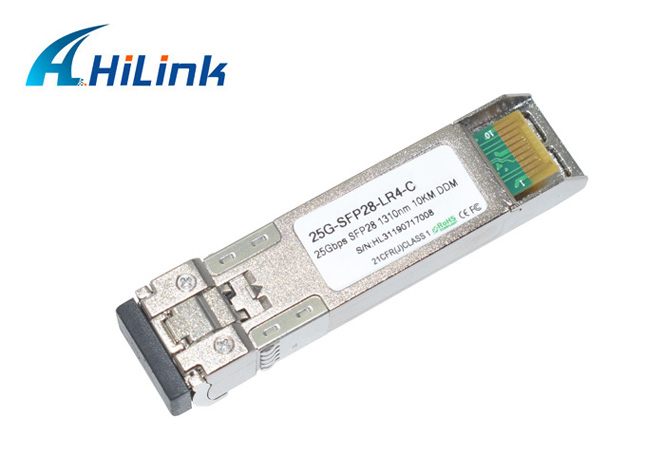What Is the Connection between 25G/50G/100G Technologies?
Aug. 17, 2022
Over the past decade, 10G and 40G technologies have dominated the majority of the Ethernet market; however, as users demand higher bandwidth and the need to develop special applications, 25G/50G/100G technologies are gaining more and more attention, and they are gradually standing out in network deployments by virtue of their ability to provide an efficient path to high-speed rates. The optical module supplier will focus on 25G/50G/100G technologies and the relationship between the three.
25G technology
The 25G Ethernet standard was introduced in 2016 by the IEEE for servers in cloud data centres, a few years after the 10G/40G/100G Ethernet standard. 25G's main advantage is the use of SerDes technology, a mainstream time-division multiplexing (TDM), point-to-point (P2P) serial communications technology that makes full use of channel capacity of the transmission media, minimising the number of transmission channels and device pins required, thereby increasing the signal transmission rate and significantly reducing communication costs.
Hilink 25G SFP28 LR 10km optical transceivers are designed for 25GBASE-LR SFP28 Ethernet and CPRI/eCPRI links, reach up to 20km over Single-Mode Fiber (SMF).
Currently, most components used in switches run SerDes with a clock rate of approximately 10Ghz, providing 10Gbps transmission rates between different components. In recent years due to the rapid development of SerDes technology, SerDes with a clock rate of 25Ghz has become one of the economically viable options, which has led to the differentiation of 10G and 40G from 25G in terms of cost and benefits. For example.
10G VS 25G - the same SerDes channel, 25G provides 2.5 times more throughput than that provided by 10G. When upgrading from a 10G network to a 25G, cost savings can be achieved as the 25G SFP28 optical module can use the LC patch cables used for 10G network cabling, eliminating the need for rewiring.
40G vs 25G - 40G uses four 10Gbps Fibre Channels (SerDes clocked at 12.5Ghz), while 25G uses a single channel of SerDes, so 25G offers higher port density. At the same time, 10G-40G inevitably increases cable costs as most 40G QSFP+ optical modules on the market need to be used with MTP/MPO patch cables.
50G technology
As 25G technology matures and users demand higher speed rates, the industry has strong expectations for 50G. In 2018, IEEE introduced the 50G Ethernet standard, which shares the same architecture as the 400G/200G Ethernet standard, which uses PAM4 technology for efficient bandwidth utilisation, making it the next solution for high-speed connectivity to servers and data centres. Since 50G can reuse 25G SFP28components from existing 100G networks, it can effectively reduce costs. At the same time, 50G is half the cost of 40G but offers a 25% performance increase.

As PAM4 technology maps pairs of bits into individual symbols, the total baud rate per 50Gbit/s channel is 26.5625 Gbaud. 50Gbaud PAM4 can deliver 100G transmission rates with a 1*2*50 Gbaud architecture (only one laser is required), which means that the use of a single laser can increase the transmission rate from 10Gbps to 100Gbps, a tenfold increase. PAM4 technology is widely used in high-speed signal interconnections as it offers higher transmission efficiency at a lower cost than earlier NRZ technology.
100G technology
100G Ethernet was officially released in 2010 and the standard has been extensively changed to meet the needs of high speed, long-distance and certain special scenarios. 100G is gradually replacing 40G, thanks to the continuous optimisation of the standard, the harmonisation of technical solutions, the development of the industry chain and the higher transmission rates and longer distances (using DWDM technology) that this brings.
100G DWDM technology enables long-distance, high-capacity signal transmission on a single wavelength and is particularly suitable for high-speed optical communications. In particular, coherent CFP DWDM optical modules are suitable for 100G metropolitan area networks (MAN) or data centre interconnects (DCI) up to 80 km or very long links with transmission distances of more than 1000 km. In addition, in the case of multi-rate and multi-protocol networks (e.g. 10G/40G/100G Ethernet protocols and rates), the use of 100G DWDM multiplexers can effectively avoid network architecture redesign and planning by directly combining signals of different protocols and rates into a single wavelength for transmission up to 100G, providing a flexible and cost-effective solution. It provides a flexible and cost-effective solution.
What is the connection between 25G/50G/100G?
25G/50G/100G is now widely used in cloud data centres, and when brought together the three can be used to upgrade 10G-25G-50G-100G networks, whereas prior to 25G and 50G, 100G networks were upgraded by 10G-40G-100G, which was inefficient and expensive. In contrast, 25G is the most cost-effective solution for upgrading to 100G. A 100G network upgrade using 25G can be achieved using a spine lobe architecture with 4*25G or 2*50G SerDes channels.
In this way, 25G can be upgraded based on existing cabling infrastructure due to its compatibility, providing higher transmission efficiency and performance while saving CAPEX and OPEX. In summary, the 25G-50G-100G network upgrade path reduces the cost per unit of bandwidth by leveraging switch port functionality, while laying the foundation for 200G and 400G network upgrades.











